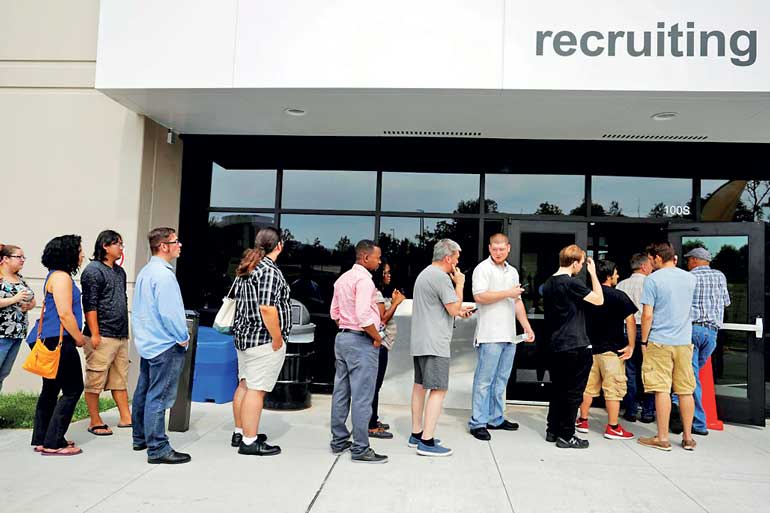Sunday Dec 15, 2024
Sunday Dec 15, 2024
Tuesday, 26 December 2017 00:00 - - {{hitsCtrl.values.hits}}
 Job seekers line up to apply during "Amazon Jobs Day," a job fair being held at 10 fulfillment centers across the United States aimed at filling more than 50,000 jobs, at the Amazon.com Fulfillment Center in Fall River, Massachusetts, U.S., August 2, 2017. - REUTERS/File Photo
Job seekers line up to apply during "Amazon Jobs Day," a job fair being held at 10 fulfillment centers across the United States aimed at filling more than 50,000 jobs, at the Amazon.com Fulfillment Center in Fall River, Massachusetts, U.S., August 2, 2017. - REUTERS/File Photo
Washington (Reuters): The US economy grew at its fastest pace in more than two years in the third quarter, powered by robust business spending, and is poised for what could be a modest lift next year from sweeping tax cuts passed by Congress this week.
While other data on Thursday showed a jump in the number of Americans filing for unemployment benefits last week, the underlying trend in jobless claims remained consistent with a tightening labor market.
The strong economy and tight jobs market has led many analysts to question the need for the $ 1.5 trillion tax cut package.
“We’ve never seen a Congress in history serve up tax cuts on a platter to businesses and individuals unless the economy was in recession,” said Chris Rupkey, chief economist at MUFG in New York. “Better buckle up ... it could be a wild ride in 2018.”
Gross domestic product expanded at a 3.2% annualised rate last quarter, the Commerce Department said in its third GDP estimate for the period. Although that was slightly down from the 3.3% reported last month, it was the quickest pace since the first quarter of 2015 and was a pickup from the second quarter’s 3.1% growth rate.
It also was the first time since 2014 that the economy enjoyed growth of 3 percent or more for two straight quarters. Retail sales, labor market and housing data as well as other reports have suggested the economy maintained its solid momentum in the fourth quarter.
Republicans in Congress this week approved the largest overhaul of the tax code in 30 years, handing President Donald Trump a major legislative victory. Trump is expected to sign the legislation soon.
The Trump administration has portrayed the tax bill as key to boosting economic growth and creating jobs.
Economists are forecasting a modest economic boost from the tax changes, which include slashing the corporate income tax rate to 21 percent from 35 percent. Many of them believe the lower tax regime will lead to share buybacks and debt repayment rather than a boost in business investment.
With income tax cuts for individuals skewed toward higher-income households, economists also forecast only a marginal lift to consumer spending.
“The contribution of the tax cuts to aggregate economic growth will be modest, in the range of one-tenth to two-tenths of a percent,” said Anne Van Praagh, managing director of global credit strategy and research at Moody’s Investors Service in New York.
“We do not believe that the corporate tax cuts will meaningfully increase business investment spending.”
The fiscal stimulus is expected to come when the economy is at full employment, which raises the risk of it overheating.
Economists, as a result, see a faster pace of interest rate increases from the Federal Reserve than currently anticipated. The US central bank raised interest rates last week for a third time this year and has forecast three rate hikes for 2018.
US stocks were trading higher as investors continued to cheer the tax cuts. Prices for shorter-dated US Treasuries fell, while the dollar .DXY was little changed against a basket of currencies.
The growth in the third quarter, however, likely overstated the economy’s health. An alternate measure of growth, gross domestic income, rose at a 2.0% rate in the period. GDI was previously reported to have increased at a 2.5% rate.
The average of GDP and GDI, also referred to as gross domestic output and considered a better measure of economic activity, increased at a 2.6 percent rate in the third quarter instead of the previously reported 2.9 percent.
The pace of growth in business investment in equipment was raised to 10.8 percent, the fastest in three years, from the previously reported 10.4 percent. There were also upward revisions to government spending and residential construction.
Growth in consumer spending, which accounts for more than two-thirds of the U.S. economy, was trimmed by one-tenth of a percentage point to a 2.2 percent rate in the third quarter. Investment in inventories was lowered slightly.
In a separate report, the Labor Department said initial claims for state unemployment benefits rose 20,000 to a seasonally adjusted 245,000 for the week ended Dec. 16.
Last week marked the 146th straight week that claims remained below the 300,000 threshold, which is associated with a strong labor market. That is the longest such stretch since 1970, when the labor market was smaller.
The labor market is near full employment, with the jobless rate at a 17-year low of 4.1 percent. Last week, the four-week moving average of initial claims, considered a better measure of labor market trends as it irons out week-to-week volatility, rose only 1,250 to 236,000.